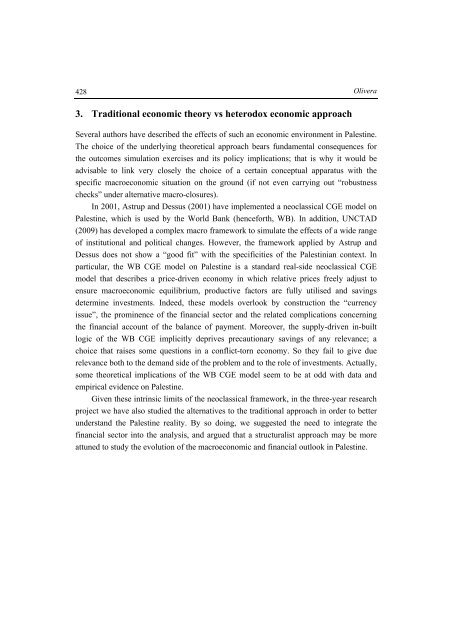The Palestinian Economy. Theoretical and Practical Challenges
The Palestinian Economy. Theoretical and Practical Challenges
The Palestinian Economy. Theoretical and Practical Challenges
You also want an ePaper? Increase the reach of your titles
YUMPU automatically turns print PDFs into web optimized ePapers that Google loves.
428<br />
Olivera<br />
3. Traditional economic theory vs heterodox economic approach<br />
Several authors have described the effects of such an economic environment in Palestine.<br />
<strong>The</strong> choice of the underlying theoretical approach bears fundamental consequences for<br />
the outcomes simulation exercises <strong>and</strong> its policy implications; that is why it would be<br />
advisable to link very closely the choice of a certain conceptual apparatus with the<br />
specific macroeconomic situation on the ground (if not even carrying out “robustness<br />
checks” under alternative macro-closures).<br />
In 2001, Astrup <strong>and</strong> Dessus (2001) have implemented a neoclassical CGE model on<br />
Palestine, which is used by the World Bank (henceforth, WB). In addition, UNCTAD<br />
(2009) has developed a complex macro framework to simulate the effects of a wide range<br />
of institutional <strong>and</strong> political changes. However, the framework applied by Astrup <strong>and</strong><br />
Dessus does not show a “good fit” with the specificities of the <strong>Palestinian</strong> context. In<br />
particular, the WB CGE model on Palestine is a st<strong>and</strong>ard real-side neoclassical CGE<br />
model that describes a price-driven economy in which relative prices freely adjust to<br />
ensure macroeconomic equilibrium, productive factors are fully utilised <strong>and</strong> savings<br />
determine investments. Indeed, these models overlook by construction the “currency<br />
issue”, the prominence of the financial sector <strong>and</strong> the related complications concerning<br />
the financial account of the balance of payment. Moreover, the supply-driven in-built<br />
logic of the WB CGE implicitly deprives precautionary savings of any relevance; a<br />
choice that raises some questions in a conflict-torn economy. So they fail to give due<br />
relevance both to the dem<strong>and</strong> side of the problem <strong>and</strong> to the role of investments. Actually,<br />
some theoretical implications of the WB CGE model seem to be at odd with data <strong>and</strong><br />
empirical evidence on Palestine.<br />
Given these intrinsic limits of the neoclassical framework, in the three-year research<br />
project we have also studied the alternatives to the traditional approach in order to better<br />
underst<strong>and</strong> the Palestine reality. By so doing, we suggested the need to integrate the<br />
financial sector into the analysis, <strong>and</strong> argued that a structuralist approach may be more<br />
attuned to study the evolution of the macroeconomic <strong>and</strong> financial outlook in Palestine.
















